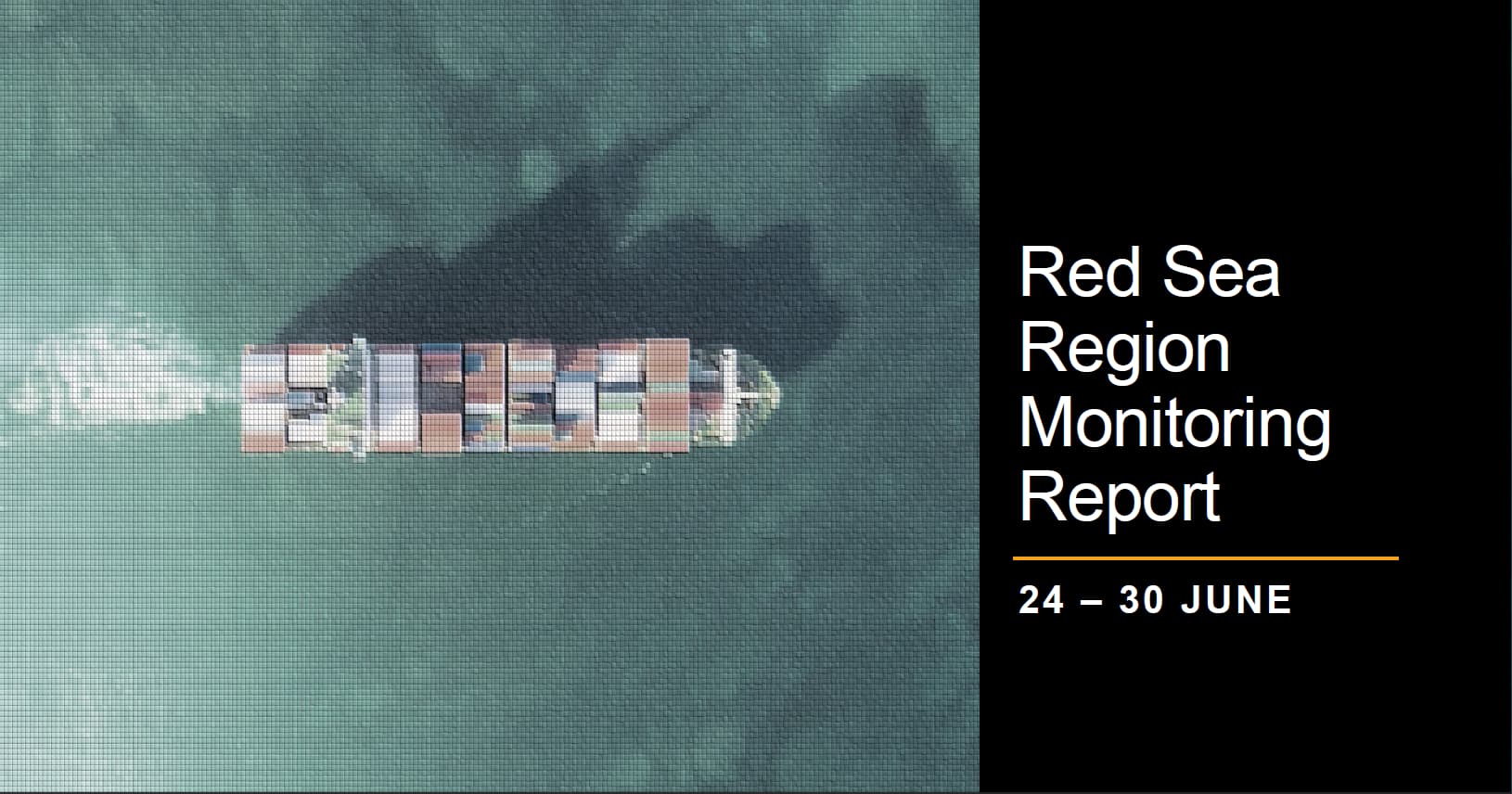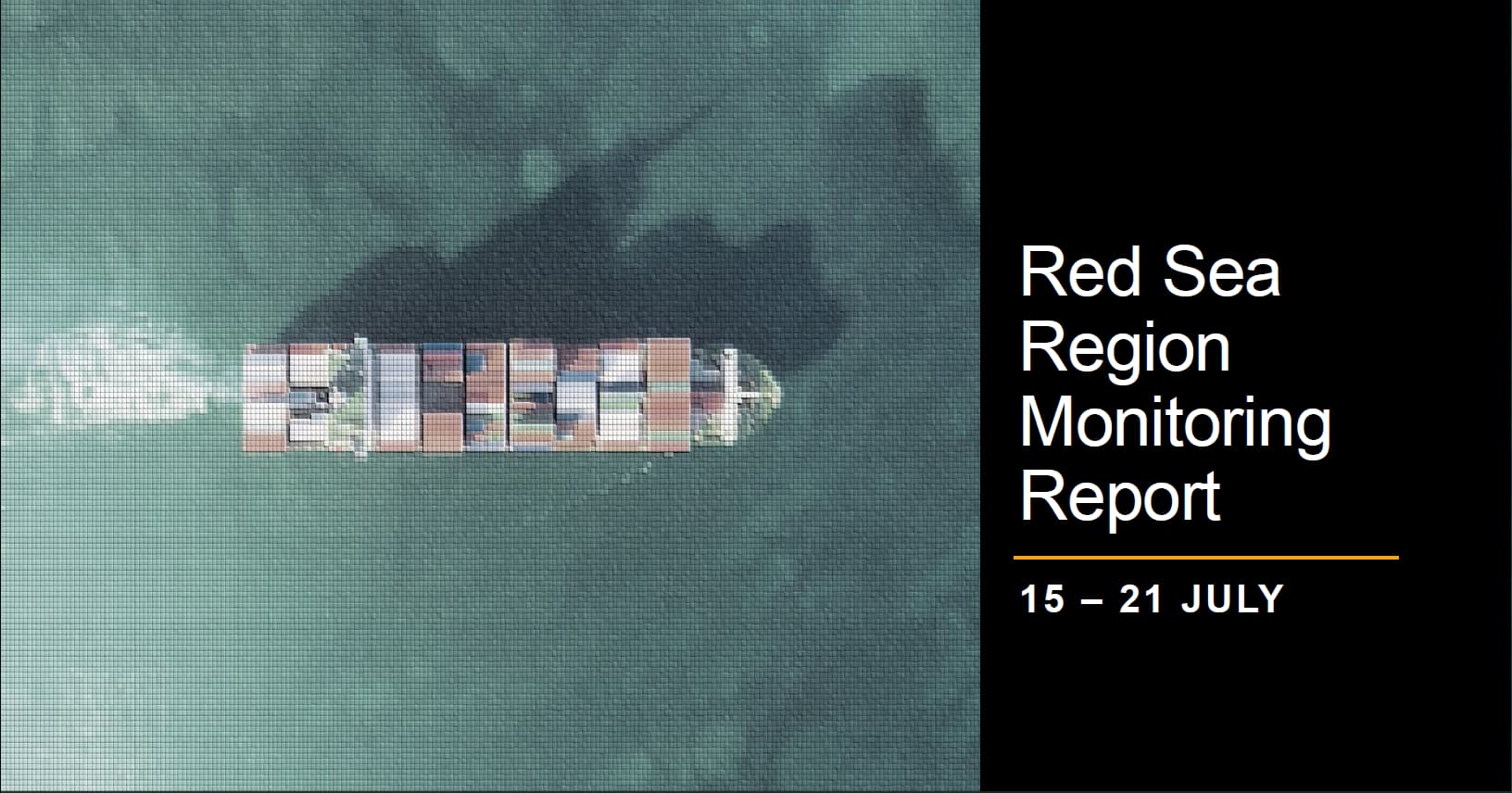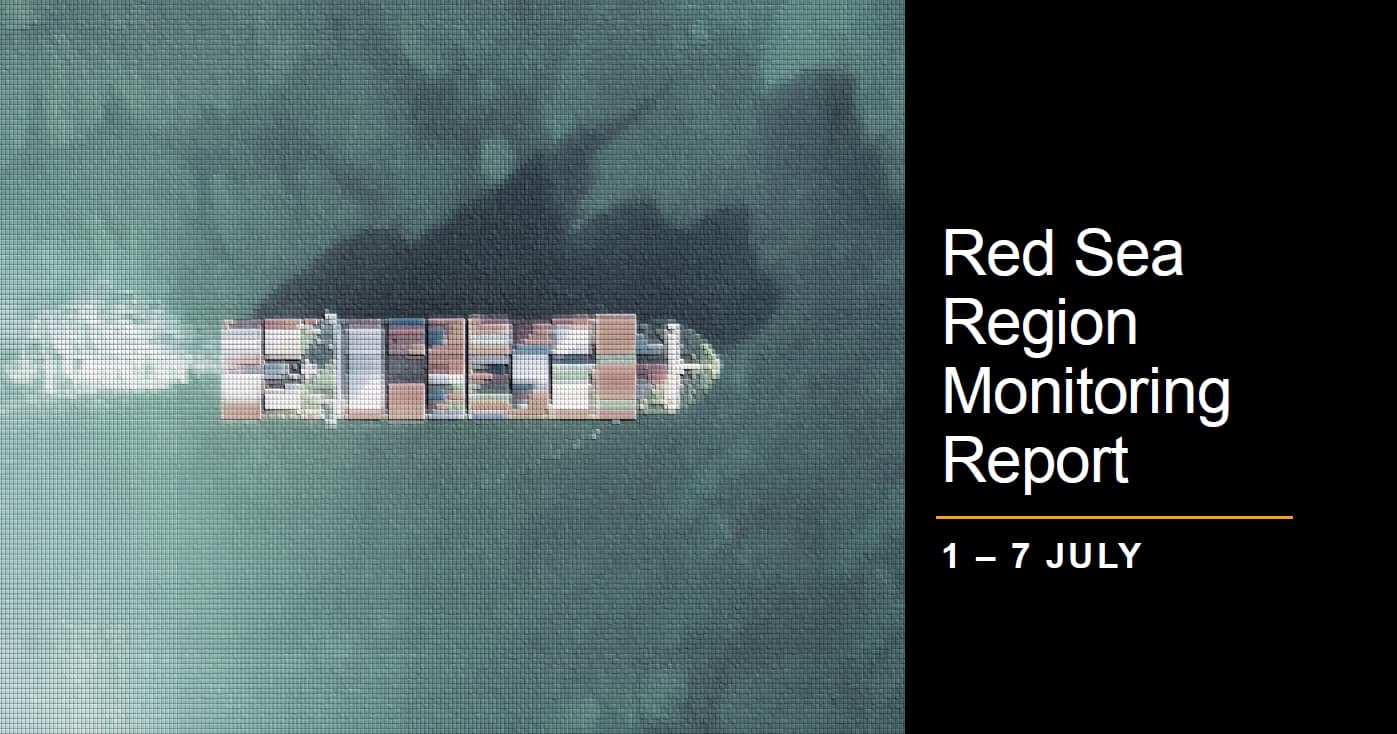KEY DEVELOPMENTS – COMMERCIAL INCIDENTS
During the monitoring period 20 – 26 May Regal Maritime Solutions (RMS) identified the following incidents in the Red Sea and Gulf of Aden region:
MISSILE ATTACK: On 23 May, a missile was reported as hitting the water close to the vicinity of a commercial vessel 98NM south of Al Hudaydah, Yemen. The vessel and crew were reported safe and continued to its next port of call.
PIRACY INCIDENT: On 23 May an unspecified number of suspected pirates boarded the Liberian flagged merchant vessel, the MV BASILISK from two small craft, 380NM east of Mogadishu, Somalia. The BASILISK whilst transiting the Indian Ocean in the vicinity of position 0116S 05107E when it was boarded. It was later confirmed on 24 May that the vessel had been recovered following a military intervention by EUNAVFOR Operation ATALANTA.
IRANIAN INTELLIGENCE VESSEL: There have been no updates on the Iranian intelligence vessel the Behshad during the reporting period. Its last reported location was on 18 April in the Persian Gulf in Iranian territorial waters. It was located in the vicinity of coordinates 26° 59′ 26.2″ N, 056° 24′ 35.2″ E located approximately 5NM south of Banda Abbas, Iran and south west of the island of Hormuz.

KEY DEVELOPMENTS – MILITARY ACTIVITY
During the monitoring period 20 – 26 May RMS identified the following incidents involving US coalition forces in the Red Sea and Gulf of Aden region, obtained from military and open sources:
HOUTHI UAV INTERCEPT: On 21 May Houthi air defences in Yemen intercepted and destroyed a US MQ-9 Reaper drone over Al-Bayda province, Yemen. Houthi spokesperson Brigadier General Yahya Saree indicated the drone was intercepted whist performing “hostile activities.” The US military acknowledged reports of the downing but has not commented on the event. This follows on from another US MQ-9 Reaper drone intercept by Houthi forces on 17 May.
UAV INTERCEPT: On 22 May at approximately 1516 local time US forces engaged and destroyed four unmanned aerial vehicles (UAV) in Houthi controlled areas of Yemen, determined as presenting an imminent threat to US, coalition and commercial vessels in the region.
MISSILE INTERCEPT: On 23 May at approximately 0726 local time Houthis militants launched two anti-ship ballistic missiles (ASBM) into the Red Sea. No vessels were damaged or injuries reported by US, coalition or commercial ships in the region.
MISSILE INTERCEPT: On 23 May at approximately 2010 local time US forces identified and engaged one Land Attack Cruise Missile (LACM) in a Houthi-controlled area of Yemen, which was considered as presenting an imminent threat to shipping in the region.
MISSILE INTERCEPT: On 25 May at approximately 1550 local time Houthi militants launched two anti-ship ballistic missiles (ASBM) toward the Red Sea. No injuries or damage were reported by either US, coalition, or commercial ships in the area.
UAV INTERCEPT: On 26 May at approximately 1000 local time, US forces intercepted and destroyed one UAV over the Red Sea which had been launched from a Houthi controlled area of Yemen.
EUNAVFOR PIRACY INTERVENTION: On 24 May, an EU warship associated to EU Naval Force (EUNAVFOR) Operation ATALANTA intercepted and boarded the German managed, Liberian-flagged Merchant Vessel BASILISK via aerial boarding. The BASILISK had been pirated on 23 May by a suspected Pirate Action Group (PAG) whilst transiting the Indian Ocean, in which a crew member was injured. The resulting action ensured the successful liberation of the vessel and the 17 crew aboard. The injured crew member received medical attention and was reported to be in a stable condition.

KEY DEVELOPMENTS – HOUTHI MISSILE STATISTICS

Figures 1 and 2 identifies the number of missiles, UAV, USVs and UUVs launched, or prepared to be imminently launched, by Houthi militants from Yemen targeting commercial and naval vessels in the Red Sea and Gulf of Aden regions. Figures have incorporated statistics from vessels hit, near misses and pre- emptive strikes on-land in Yemen by US-led Coalition forces but not those resulting from large scale coordinated military action. In some cases the destined target of Houthi weapons including destroyed on-land in Yemen cannot not be verified and has therefore been categorised as ‘Not Known’ (NK). Where no dates are provided there were no reported incidents or data available for that period.
ANALYSIS: There has been no significant change in the intensity or frequency of Houthi missile and UAV attacks over the reporting period compared to previous weeks. The majority of Houthi attacks over the monitoring period has been focused in the Red Sea region rather than the Guff of Aden, with no attacks attempted in the Indian Ocean or Arabian Sea.
KEY DEVELOPMENTS – SECURITY INCIDENT MAPPING


REGIONAL DEVELOPMENTS
During the monitoring period 20 – 26 May RMS identified the following key regional developments:
The Secretary-General of Iraq’s Hezbollah brigades, Abu Hussein Al-Hamedawi, discussed developments on the situation in Gaza with the Yemein Houthi leader Abdul- Malik al-Houthi and regarding coordination among both forces in solidarity with Gaza. Al- Hamedawi emphasised the importance of maintaining a high state of readiness and coordination among the Axis of Resistance forces (Iran supported militant groups in the region), particularly between Iraq and Yemen.
On 20 May, the chief prosecutor of the International Criminal Court (ICC), Karim Khan, announced that he would be applying to the court for arrest warrants for both Israeli Prime Minister Benjamin Netanyahu and Israeli Defence Minister Yoav Gallant for crimes against humanity. This is in addition to a proposed charges against Hamas leaders Yahya Sinwar, Mohammed Diab Ibrahim Al-Masri and Ismail Haniyeh, as well its military wing and political bureau.
On 20 May Israel’s Defence Minister Yoav Gallant announced that the Israeli Defense Force (IDF) will be expanding operations in the southern Gazan city of Rafah. This was done despite US concerns about the risk of mass casualties FROM a major ground operation in the city, placing pressure on Israel’s already tense relationship with its main ally. The US had already indicated it would withhold weapon shipments to Israel over the potential impact of its planned operations on civilian lives.
On 20 May, thousands of demonstrators in Israel gathered in front of the Israeli parliament, the Knesset, to call for immediate elections and the release of all remaining hostages in Gaza. The protests saw 12 people arrested.
On 24 May the IDF discovered the bodies of three hostages taken by Hamas on 7 October 2024. This followed an earlier discovery on 17 May where three other hostage’s bodies were found by the IDF operating in Gaza. The IDF claims around 100 hostages remain in Gaza, along with 30 who are believed to have died.
On 22 May, Ireland, Spain and Norway announced they would recognise Palestine as a state on 28 May. Norwegian Prime Minister Jonas Gahr stated that a two-state solution is in Israel’s interest to bring peace to the middle east. This is the first time three nations have recognised Palestinian statehood since 2020. Israel responded by recalling its diplomatic presence from all three countries.
On 23 May, the Islamic Resistance in Iraq, which consists of a loose formation of armed groups affiliated with the Popular Mobilization Forces, including Iraq’s Hezbollah brigades, launched a morning and evening UAV attack on the Israel port city of Eilat. The group also claimed to have targeted the Israel port city of Haifa utilising both UAVs and a cruise missile. The IDF reportedly intercepted the attacks.
Following the death of Iranian President Ebrahim Raisi, alongside the Iranian Defence Minister Hossein Amir-Abdollahian on 19 May in a helicopter crash, elections for the Raisi’s successor will take place on 28 June. It is expected a Raisi will be replaced by a fellow hardliner. Despite Raisi’s death the political climate in the country remains stable as Supreme Leader Ayatollah Khamenei attempts to ensure a smooth political transition.
EUNAVFOR has confirmed that Kenya will now be able to prosecute suspects linked to piracy related events due to the increasing number of maritime cases being managed by courts in the Seychelles.
ASSESSMENT
- Increased coordination between axis of resistance members in particular the Houthis and Islamic Resistance in Iraq, demonstrates an increased effort to coordinate actions to target Israeli interests. The attack follows a similar attempt by the Islamic Resistance in Bahrain, Saraya Al-Ashtar (Al-Ashtar Brigades) on 27 April and 2 May. Despite the Islamic Resistance in Iraq’s attempts to target Israeli port cities, the risk of commercial shipping being directly struck in these areas are considered low, considering other higher target profiles in the area, and effective Israeli air defence systems.
- The Red Sea, Gulf of Aden, Somalia, Arabian Sea and Indian Ocean remain a high risk of piracy and of vessel damage from Houthi attacks in the region.
- Houthi attacks will continue to target commercial and military vessels in the Red Sea and Gulf of Aden and seek to target shipping further afield in the Indian ocean and Arabian Sea. This will be limited on Houthi weapon capability, availability and opportunity. The expanded risk zone will result in further disruption to maritime logistic lines.
- Successful Houthi long-range attack is low compared to vessels targeted in the Red Sea and Gulf of Aden, with most long-range attacks likely failing to reach the intended target. Nonetheless, the threat posed is enough to cause disruption to shipping routes.
- Vessels linked to Israel, the US and UK will remain primary, but not sole targets for Houthi militants. Houthi use of inaccurate data and intelligence pertaining to target identification, and/or maintaining an effective command and control procedure with local units, places non Israeli, US and UK vessels at a risk of being misidentified, including Russian and Chinese linked vessels.
- Iran will continue to support its proxies to avoid direct confrontations with Israel and will continue to provide weapon and weapons components in support of Houthi maritime attacks in the region via its shipping vessels and smuggling networks.
- The death of Iranian President Raisi, the regional security situation has not dramatically increased as a consequence.
- The expanded ground offensive in Rafah by the Israeli Defense Forces (IDF) will likely see further strikes against Israeli interests by axis of resistance forces including Islamic Resistance in Iraq and Yemen based Houthi militants – whose primary focus remains to target shipping in the region. Any ceasefire between Israel and Hamas, may see a temporary pause in attacks.
- The US and its partners will continue to conduct pre-emptive strikes against Houthi targets on-land in an attempt to degrade Houthi military capability and prevent it to be used to target commercial shipping and from being used as a platform to target Israel.
- The US will continue to intensify efforts to intercept vessels smuggling weapon components from Iran to the Houthis in Yemen and expand intelligence collection methods to enhance maritime interdiction operations, as well as coordinate military strikes against Houthi weapon sites, facilities and capabilities in Yemen.
- The US government will continue to push for a diplomatic solution for the Israel-Hamas conflict with regional partners due to the ongoing humanitarian crisis in Gaza and attempt to prevent escalatory military activity by the Israeli government in Rafah which may heighten the risk to civilians.
RECOMMENDATIONS
- Merchant and other vulnerable vessels are recommended to register with the Maritime Security Centre – Horn of Africa’s Voluntary Registration Scheme due to heightened piracy threat in the Indian ocean.
- Avoid being in vicinity of Iranian Behshad vessel. Avoid where possible transiting locations within the UAE and Iranian coastlines due to the risk from Iranian military boarding parties.
- Vessels operating in the Indian Ocean area are urged to heighten their vigilance due expanded risk area from Houthi missile and UAV attack and continued threat from Pirate Activity Groups (PAGs) in the area.
- Report any Suspicious Sightings and be aware of the risk of Unmanned aerial Vehicle (UAV) / drone and Uncrewed Surface Vehicle (USV) attack.
- Consider utilising a digital monitoring system, which incorporates UAV/UUV drone monitoring to warn of potential attack and use of physical barriers, such as nets and underwater barriers, that can be deployed to prevent UUVs from approaching a ship. These barriers can entangle or obstruct the movement of a UUV..
- Ensure crew conduct drills and training exercises to respond to UUV threats so that they are well-prepared to take appropriate action in the event of an incident.
- Follow guidance on loitering munitions as per the OCIMF website: https://www.ocimf.org/publications/information-papers/loitering-munitions-%E2%80%93-the-threat-to-merchant-ships
- Implement and review BMP5 in particular section 2, which describes non-piracy threats and the Global Anti-Piracy Guide.
- Consider mentioning vessel location to Flag Authorities.
- Inform UKMTO/MSCHoA of vessel movements and ensure radar is kept on.
- Communicate with local agents for any local information or intelligence.
- Keep VHF Ch16 on and pay attention to advisories. Ensure strict surveillance of communications and establish communication with all approaching vessels.
- Do not allow small boats to approach or dock. Consider utilizing an armed security team aboard.
- Ensure there is Hard Cover available if on deck and that it is accessible.
- Ensure a Secondary Muster Station is considered and identified to crew and not just the citadel.
- Maintain Bridge Watches. (Please be aware at night, small, slow vessels without a wake are difficult to detect on radar). Keep Traffic on Upper Deck to a minimum
- Ensure all fire-fighting equipment is checked and available for immediate use. Including the emergency fire pump and that relevant maintenance has been conducted.





